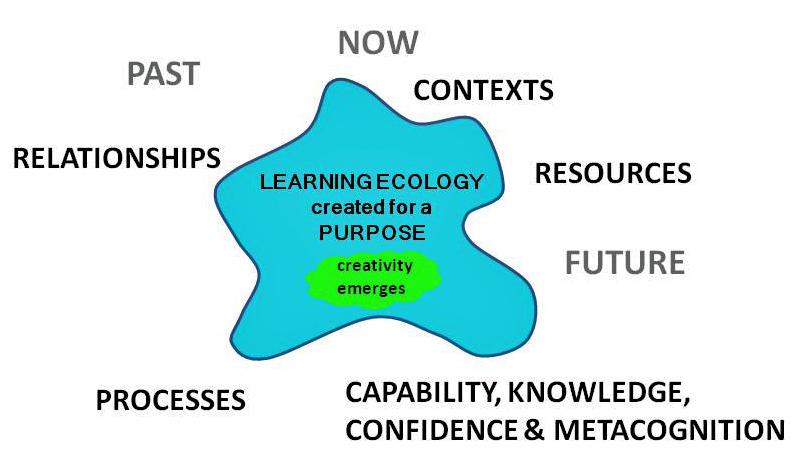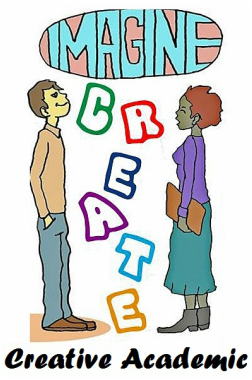To illustrate the concept of a learning ecology and show how a narrative might be created to reveal the nature of personal creativity and how it emerges through our interactions with materials, events, people and circumstances of our life, I offer an example below. The illustration shows my learning ecology for two connected projects I undertook between August and early October 2014. I produced it initially to show students I was teaching at Beijing Normal University what I meant by a learning ecology and how I had used the tools of the Social Age to learn something that was new to me.
My ecology contains two cycles of activity over about 10 weeks. The first involved learning in order to produce an issue of Lifewide Magazine dedicated to Exploring the Social Age of Learning. The second cycle was the learning process I created in order to prepare for teaching a short course on the Social Age at Beijing Normal University. At the end of this process I knew I had developed my understanding of the concept of learning in the Social Age and also developed new knowledge on the way social media is being used by young people in China.

1 HISTORY - When we start any learning project we do not begin with a blank sheet of paper, rather we start with all sorts of background knowledge, assumptions and questions some of which is relevant much of which isn’t. Some of which is helpful but some is not. We also start with process knowledge - knowing how to learn and develop in this particular context. This is the most important knowledge we posses.
2 In May 2014 I was working on a learning project to develop understanding around the use of social media in learning and development and discovered Julian Stodd's blog and e-book. His ideas seemed relevant and significant to my mission to develop knowledge relating to lifewide learning (my professional interest). I decided to use the theme of Exploring the Social Age for the September issue of Lifewide Magazine - a curated collection of stories. I got in touch with Julian and invited him to be Guest Editor which he kindly accepted, and then I set about developing content and finding others to help me using my personal learning networks (PLN) and on-line searches which enabled me to expand my PLN. I came across a number of blogs that were relevant and got in touch with a number of authors. I made a number of useful contacts and relationships extending my own networks in the process and connecting their knowledge to the Magazine project.
3 Production of the Magazine through August and September 2014 involved organising and editing the articles and creating a commentary and structure that made sense to me and hopefully the readers. I also worked with our community artist to create illustrations that communicated ideas – I used these narratives not only in the Magazine but also in the blogs and other social media and later in my lecture materials. Following publication of Lifewide Magazine in September through our web 2.0 website and Paper Li and Academia.eu I posted blogs on several websites and social media platforms (Linked In, Facebook) and my own blog, and circulated notices via twitter.
SECOND CYCLE OF ACTIVITY
4 After publication of the Magazine in late September I began to prepare my lectures for BNU. Over a few days I engaged in further searching using google and discovered a wealth of materials much of it research-based on websites, blogs, YouTube. I also began researching the use of social media in China. I worked with a former BNU student who helped me develop questionnaires and posted them on Survey Monkey (Web 2.0 tech) to gain perspectives on the use of social media amongst Chinese students. During my week-long visit to BNU I worked with two Chinese students to help me engage their peers in the on-line surveys. The knowledge that was developed was then utilised in the teaching process. I created a new website ‘BNUlectures’ to host resources to support learning with BNU students and the new knowledge we had co-created.
5 I am still consolidating and refining what I have learnt and have begun to write a chapter on the Social Age for our on-line e-book.
EVALUATING MY CREATIVITY IN THIS ECOLOGICAL PROCESS
1 CREATION OF A NEW AND UNIQUE ECOLOGY for learning, development and achievement
2 PRODUCTION of a NEW magazine including the CO-CREATION of content and illustrations
3 The NEW ways I used social media to disseminate the Magazine and its content
4 The way I connected and synthesised existing knowledge to CREATE a NEW STORY appropriate for my teaching context
5 The production of NEW resources for teaching – like the representation of my learning ecology
and the design and content of a NEW website to support the learning process
6 The design of a NEW questionnaire to facilitate sharing of students’ personal knowledge about their use of social media
7 The teaching performance – NEW TOPIC for a new student group
8 The NEW relationships that have been formed from which NEW things were grown and continue to grow
This story illustrates how our creative ideas are turned into actions that enable us to achieve the things we value and bring new material objects, processes and performances into existence, and enable us to learn and develop - probably our most important creative product since this impacts on the way we see things and our future learning.
References,
Jackson, N. J. (2013a) The Concept of Learning Ecologies, in N. J. Jackson and G.B. Cooper (eds) Lifewide Learning, Education and Personal Development E-book Chapter A5 available on-line at http://www.lifewideebook.co.uk/conceptual.html
Jackson, N. J. (2013b) Learning Ecology Narratives, in N. J. Jackson and G. B. Cooper (eds) Lifewide Learning, Education and Personal Development E-book Chapter C4 available on line at: http://www.lifewideebook.co.uk/research.html
Jackson, N.J. (2014) Lifewide Learning and Education in Universities & Colleges: Concepts and Conceptual Aids in N Jackson and J Willis (eds) Lifewide Learning and Education in Universities and Colleges Chapter 1 available at: http://www.learninglives.co.uk/e-book.html
Rogers, C. (1961) On becoming a person. Boston: Houghton Mifflin


 RSS Feed
RSS Feed
